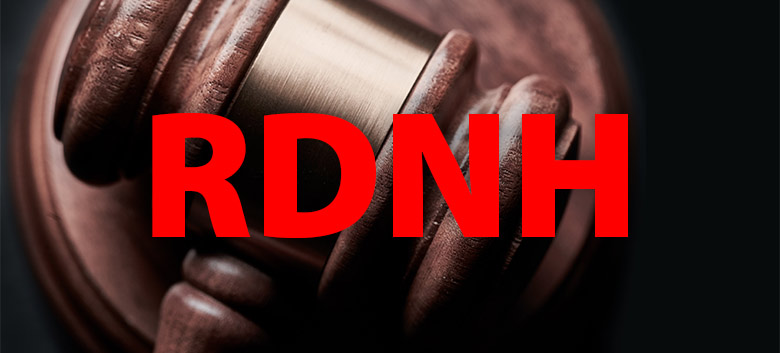Redcat Pty Ltd, an Australian IT company, went after Redcat.com, claiming rights through trademarks filed only in late 2024. The domain, however, had been registered nearly three decades earlier (in 1996) by Oregon-based technologist Tom Phoenix, who had long used it for email and published contact info tied to the domain as early as 1997.
The Complainant offered little substance beyond its new trademarks and vague claims of a 30-year brand presence, unsupported by evidence. Its prior efforts to buy the domain never asserted any legal rights. When ignored, it escalated to a UDRP filing that lacked proof of bad faith, omitted key facts, and misrepresented its trademark timeline. The Respondent established legitimate long-term use and business registration under the Redcat name and thus the WIPO Panel found no evidence of targeting or cybersquatting.
Final decision: Deny the transfer of Redcat.com to the Complainant, finding the latter guilty of Reverse Domain Name Hijacking:
The Panel also considers that the Complaint was misleading by omission in that it failed to make clear that the Complainant’s registered trademarks were only obtained very recently. It also did not make clear that the Complainant’s own Internet presence post-dated the registration of the Disputed Domain Name by five years. Overall the Complaint lacked any foundation for the allegations that the Respondent must have had the Complainant in mind when he registered the Disputed Domain Name. If the Complainant took competent legal advice before filing the Complaint it should have appreciated that it had no realistic prospect of success. If it did not take competent legal advice it should have carried out some basic research as to what it needed to show, and realised for itself it could not succeed. If it did not do this it has only itself to blame. In all the circumstances the Panel agrees with the Respondent that the Complaint was brought in bad faith and constitutes an abuse of the administrative proceeding.”

Copyright © 2025 DomainGang.com · All Rights Reserved.ARBITRATION AND MEDIATION CENTER – ADMINISTRATIVE PANEL DECISION
Redcat Pty Ltd v. Tom Phoenix, Redcat
Case No. D2025-22491. The Parties
The Complainant is Redcat Pty Ltd, Australia, represented internally (see discussion below as to Complainant identity).
The Respondent is Tom Phoenix, Redcat, United States of America, represented by Law Works LLC, United States of America.
2. The Domain Name and Registrar
The disputed domain name redcat.com (the “Disputed Domain Name”) is registered with EasyDNS Technologies Inc. (the “Registrar”).
3. Procedural History
The Complaint was filed with the WIPO Arbitration and Mediation Center (the “Center”) on June 10, 2025. On June 12, 2025, the Center transmitted by email to the Registrar a request for registrar verification in connection with the Disputed Domain Name. On June 12, 2025, the Registrar transmitted by email to the Center its verification response disclosing contact information for the Disputed Domain Name which differed from the contact information in the Complaint. The Center sent an email communication to the Complainant on June 13, 2025, providing the registrant and contact information disclosed by the Registrar, and inviting the Complainant to submit an amendment to the Complaint. The Complainant filed an amended Complaint on June 16, 2025.
The Center verified that the Complaint together with the amended Complaint satisfied the formal requirements of the Uniform Domain Name Dispute Resolution Policy (the “Policy” or “UDRP”), the Rules for Uniform Domain Name Dispute Resolution Policy (the “Rules”), and the WIPO Supplemental Rules for Uniform Domain Name Dispute Resolution Policy (the “Supplemental Rules”).
In accordance with the Rules, paragraphs 2 and 4, the Center formally notified the Respondent of the Complaint, and the proceedings commenced on June 17, 2025. In accordance with the Rules, paragraph 5, the due date for Response was July 7, 2025. The Response was filed with the Center on July 5, 2025.
The Center appointed Nick J. Gardner, The Hon Neil Brown K.C. and Lynda J. Zadra-Symes as panelists in this matter on July 24, 2025. The Panel finds that it was properly constituted. Each member of the Panel has submitted the Statement of Acceptance and Declaration of Impartiality and Independence, as required by the Center to ensure compliance with the Rules, paragraph 7.
4. Factual Background
It is necessary to establish the identity of the Complainant. The Complaint expressly states as follows “The Complainant in this administrative proceeding is Lawrence Pelletier, shareholder of Redcat Pty Ltd”. That statement seems to the Panel to be based on some sort of misunderstanding. The substantive Complainant is clearly Redcat Pty Ltd. It is the proprietor of the registered trademarks relied upon (see below) and the remainder of the Complaint is drafted on the basis that it is the Complainant. The Panel will proceed on the same basis.
There is no information in the Complaint about what the Complainant does, what size its business is, how well known it is or indeed anything else beyond details of certain registered trademarks it owns (see below). The scope of those trademarks suggest that the Complainant’s business involves the supply of some form of IT services to the hospitality industry.
The Complainant is the owner of trademark registrations in Australia, New Zealand and the United Kingdom for the term “redcat”. See for example Australian registrations, 2443508, 2443509 and 2443510 all registered on November 25, 2024. These trademarks collectively are referred to in this decision as the “Redcat trademark”. The Australian trademarks are chronologically the earliest Redcat trademark.
The Respondent is an individual resident in Oregon, USA.
The Disputed Domain Name was originally registered on October 7, 1996.
There is no evidence before the Panel of the Disputed Domain Name ever having resolved to an active website.
5. Parties’ Contentions
A. Complainant
The Complaint acknowledges that the Disputed Domain Name was created on October 7, 1996. It does not contain any suggestion that the Respondent acquired it at any later date than this.
The Complaint provides full details of the Redcat trademarks. Beyond this it contains hardly any substantive information. The Complainant says it has been in business for over thirty years but does not provide any evidence to support this assertion. It says as follows “Our thirty years of operation have established “Redcat” as a distinctive and recognizable brand within our industry. Backed by trademark registration, our extensive and undisputed prior use in commerce confers common law trademark rights that are well-established. The public identifies “Redcat” with our goods and services”. It does not however provide any evidence to support this claim.
The Complainant submits that the Disputed Domain Name is identical to the Redcat trademark.
The Complainant says that prior to any notice of this dispute, there is no evidence that the Respondent has ever used, or made demonstrable preparations to use, the Disputed Domain Name or a name corresponding to it in connection with a bona fide offering of goods or services. The Disputed Domain Name currently resolves to a blank page or a generic placeholder, indicating a complete absence of active use. It says this lack of use strongly suggests the Disputed Domain Name was registered primarily for the purpose of preventing the Complainant from acquiring it.
The Complainant says the Respondent has never been commonly known by the name “Redcat” or the domain name redcat.com. There is no publicly available information, business registration, or any other evidence to suggest that the Respondent, whether as an individual, business, or other organization, has ever operated or been identified under this name.
The Complainant also says that the Respondent is not making a legitimate noncommercial or fair use of the Disputed Domain Name. There is no content, service, or information hosted on the domain that suggests any noncommercial intent. Furthermore, the complete lack of any use whatsoever demonstrates that the Respondent is not making any fair use of the domain. The absence of any active website or legitimate purpose strongly indicates that the domain is being held solely to prevent legitimate use by the Complainant, rather than for any bona fide non-commercial or fair purpose.
The Complaint also contains the following passages:
“Pattern of Conduct (Previous Complaint): While not explicitly stated as a pattern of the Respondent’s conduct, the mention of a “previous UDRP submission” for the same domain name (Paragraph 16) indicates a history of the Respondent holding onto the domain despite the Complainant’s clear interest and established rights. The Complainant states that the current complaint “incorporates and builds upon the arguments presented in the previous submission,“ suggesting a continued effort by the Respondent to maintain control of the domain”.
And
“Redcat Pty Ltd confirms that a previous UDRP submission was indeed made concerning
the domain name redcat.com. That initial submission highlighted our long-standing business operations of 30 years under the “Redcat” name, the Respondent’s clear cybersquatting (including their lack of use and unresponsiveness), and our superior rights to the domain. During the course of that prior proceeding, a request was made for formal trademark registration documentation to further substantiate our claim. This requirement has now been met. Therefore, this current Complaint incorporates and builds upon the arguments presented in the previous submission, with the crucial addition of formal trademark registration for “Redcat”, which is now being submitted as supporting evidence in this proceeding. We believe this new submission fully addresses any outstanding evidentiary requirements and further strengthens our case for the transfer of the domain name redcat.com”.The Panel will refer to this earlier complaint as the “Previous Complaint” – see discussion below.
The Complainant provides details of earlier approaches it made to try to purchase the Disputed Domain Name. Those communications did not contain any suggestion that the Complainant had rights in the term redcat which were superior to the Respondent’s rights. It says it did not receive any replies to these communications and says this is in itself evidence of bad faith registration and use.
B. Respondent
The Response goes into considerable detail but in summary the Respondent’s case is straightforward. The Respondent says he registered the Disputed Domain Name in 1996 for his own personal and business use, and has used it continuously since that date for email. He says that he also registered “Redcat” as a business name with the Oregon Secretary of State (Business Registry # 535770-87) in connection with a technology and consulting venture operating under that name. He provides a copy of the relevant registry entry. Respondent says he renewed the name REDCAT annually with the Oregon Secretary of State.
The Respondent annexes a copy of an article he wrote about the computer language PERL that he authored in 1997 that references his contact as . He also refers to a book related to computer programming that he authored in 2000 which, on page 183, references his contact as rootbeer@redcat.com and provides a pdf copy of the book..
The Respondent says he had never heard of the Complainant until he received this Complaint. He says he was under no obligation to reply to unsolicited enquiries about purchasing the Disputed Domain Name which in any case he thought were likely spam or a phishing scheme.
The Respondent says his searches indicate the Complainant did not have an Internet presence until March 2, 2001. The Disputed Domain Name was not registered for any reason that had anything to do with the Complainant, who he did not know of. He concedes the Disputed Domain Name is identical to the Redcat trademark but points out this trademark was only obtained in 2024 or thereafter.
The Respondent says he has no knowledge of the Prior Complaint which in any event proves nothing.
The Respondent says that the Disputed Domain Name was registered in 1996, five years before Complainant’s first known appearance on the internet in 2001, 26 years before Complainant’s trademark registrations, and 29 years before Respondent even knew of the Complainant’s existence. The Respondent’s registration of the Disputed Domain Name was not in bad faith because he could not have contemplated the Complainant’s non-existent right.
He asks for a finding of Reverse Domain Name Hijacking (“RDNH”). He says that the Complaint has been brought in bad faith because the Complainant was aware of the Respondent’s 1996 registration, and the Complainant’s trademark rights arose much later – in 2024. In addition the Complainant was not even using the name redcat on the internet until after the Respondent’s registration of the Disputed Domain Name.
6. Discussion and Findings
Procedural Issue – the Prior Complaint
The Complaint appears to indicate that the Complainant had filed an earlier complaint about the Disputed Domain Name – see above. If that were the case issues might arise as to whether the present case was barred as being a refiled Complaint – see WIPO Overview of WIPO Panel Views on Selected UDRP Questions, Third Edition (“WIPO Overview 3.0”) at section 4.18. The reference to the Prior Complaint is difficult to understand and the Panel does not know what is meant by the reference to “Paragraph 16” (see above). The Panel’s own searches of appropriate databases have not identified any previous UDRP decision concerning the Disputed Domain Name and the Respondent says he does not know anything about the Prior Complaint. The Panel infers the Complainant may have made initial preparations to bring an earlier complaint but may have received advice that its lack of registered trademarks was a problem and deferred proceeding until it had attempted to address that problem. This might explain why its registered trademarks date from very recently – 2024. In any event it does not appear that the Prior Complaint proceeded to a panel determination and the Panel does not therefore consider that the Prior Complaint prevents the present Complaint from proceeding.
Substantive matters
In order to succeed in the Complaint, the Complainant is required to show that all three of the elements set out under paragraph 4(a) of the Policy are present. Those elements are:
(i) that the Disputed Domain Name is identical or confusingly similar to a trademark or service mark in which the Complainant has rights;
(ii) that the Respondent has no rights or legitimate interests in respect of the Disputed Domain Name; and,
(iii) that the Disputed Domain Name has been registered and is being used in bad faith.A. Identical or Confusingly Similar
The Complainant has established that it is the owner of the Redcat trademark.
The Respondent correctly concedes the Disputed Domain Name is identical to this trademark and the Panel so finds. It is well established that the generic Top-Level Domain (“gTLD”), in this case “.com”, does not affect the Disputed Domain Name for the purpose of determining whether it is identical or confusingly similar. See, for example, Rollerblade, Inc. v. Chris McCrady, WIPO Case No. D2000-0429.
It does not matter for the purposes of this element that the Disputed Domain Name was registered before the Redcat trademark existed – the Panel agrees with the consensus approach as explained in WIPO Overview 3.0 section 1.1.3:
“While the UDRP makes no specific reference to the date on which the holder of the trademark or service mark acquired its rights, such rights must be in existence at the time the complaint is filed.”
Registration of a domain name before a complainant acquires trademark rights in a name does not prevent a finding of identity or confusing similarity under the UDRP. The UDRP makes no specific reference to the date on which the holder of the trademark or service mark acquired rights. However, in such circumstances it may be difficult to prove that the Disputed Domain Name was registered in bad faith under the third element of the UDRP. See below as to bad faith issues.
The panel would however add that it does not accept the Complainant’s claim to have unregistered trademark rights in the term Redcat. In this regard WIPO Overview 3.0 section 1.3 addresses this issue as follows:
“What does a complainant need to show to successfully assert unregistered or common law trademark rights?
To establish unregistered or common law trademark rights for purposes of the UDRP, the complainant must show that its mark has become a distinctive identifier which consumers associate with the complainant’s goods and/or services.
Relevant evidence demonstrating such acquired distinctiveness (also referred to as secondary meaning) includes a range of factors such as (i) the duration and nature of use of the mark, (ii) the amount of sales under the mark, (iii) the nature and extent of advertising using the mark, (iv) the degree of actual public (e.g., consumer, industry, media) recognition, and (v) consumer surveys.
(Particularly with regard to brands acquiring relatively rapid recognition due to a significant Internet presence, panels have also been considering factors such as the type and scope of market activities and the nature of the complainant’s goods and/or services.)
Specific evidence supporting assertions of acquired distinctiveness should be included in the complaint; conclusory allegations of unregistered or common law rights, even if undisputed in the particular UDRP case, would not normally suffice to show secondary meaning. In cases involving unregistered or common law marks that are comprised solely of descriptive terms which are not inherently distinctive, there is a greater onus on the complainant to present evidence of acquired distinctiveness/secondary meaning.”
In the present case there is a complete lack of any evidence supporting the claim to unregistered trademark rights and the Panel does not accept that claim.
However given the Complainant’s registered trademark rights (see above) the Panel finds that the Disputed Domain Name is confusingly similar to the Complainant’s trademark and hence the first condition of paragraph 4(a) of the Policy has been fulfilled.
B. Rights or Legitimate Interests
Paragraph 4(c) of the Policy provides a list of circumstances any of which is sufficient to demonstrate that a respondent has rights or legitimate interests in a domain name:
(i) before any notice to the respondent of the dispute, use of, or demonstrable preparations to use, the domain name or a name corresponding to the domain name in connection with a bona fide offering of goods or services; or
(ii) the respondent has been commonly known by the domain name, even if the respondent has acquired no trade mark or service mark rights; or
(iii) the respondent is making a legitimate non-commercial or fair use of the domain name, without intent for commercial gain to misleadingly divert consumers or to tarnish the trademark or service mark at issue.
While the overall burden of proof in UDRP proceedings is on the complainant, panels have recognized that proving a respondent lacks rights or legitimate interests in a domain name may result in the often impossible task of “proving a negative”, requiring information that is often primarily within the knowledge or control of the respondent. As such, where a complainant makes out a prima facie case that the respondent lacks rights or legitimate interests, the burden of production on this element shifts to the respondent to come forward with relevant evidence demonstrating rights or legitimate interests in the domain name. If the respondent fails to come forward with such relevant evidence, the complainant is deemed to have satisfied the second element. See WIPO Overview 3.0 section 2.1
The panel is doubtful that the Complainant has made out a prima facia case. Redcat is a term which involves the conjoining of two short ordinary English words (“red “ and “cat”) and could readily have been independently derived. The Complainant’s entire case comes down to saying it has found no evidence of the Disputed Domain Name being used and hence the Respondent must lack rights or a legitimate interest.
Ultimately however the Panel does not need to reach a conclusion on whether or not the Complainant has established a prima facie case. Even if the Complainant has established a prima facie case the Respondent has rebutted that case. The Respondent’s clear evidence is that he obtained the Disputed Domain Name in 1996 for his own personal and business use, and without any knowledge of the Complainant. He provides contemporaneous evidence of his use of the Disputed Domain Name for email. The Panel finds that evidence to be credible and persuasive.
In light of the above, the Panel considers that the Complainant has failed to establish that the Respondent has no rights or legitimate interests in the Disputed Domain Name. The second condition of paragraph 4(a) of the Policy has not been fulfilled.
C. Registered and Used in Bad Faith
Under paragraph 4(b) of the Policy a non-exhaustive list of factors evidencing registration and use in bad faith comprises:
(i) circumstances indicating that you have registered or you have acquired the domain name primarily for the purpose of selling, renting, or otherwise transferring the domain name registration to the complainant who is the owner of the trademark or service mark or to a competitor of that complainant, for valuable consideration in excess of your documented out-of-pocket costs directly related to the domain name; or
(ii) you have registered the domain name in order to prevent the owner of the trademark or service mark from reflecting the mark in a corresponding domain name, provided that you have engaged in a pattern of such conduct; or
(iii) you have registered the domain name primarily for the purpose of disrupting the business of a competitor; or(iv) by using the domain name, you have intentionally attempted to attract, for commercial gain, Internet users to your web site or other on-line location, by creating a likelihood of confusion with the complainant’s mark as to the source, sponsorship, affiliation, or endorsement of your web site or location or of a product or service on your web site or location.
There is no evidence that any of the above apply. The Panel finds on the evidence that the Respondent registered the Disputed Domain Name in October 1996 some 28 years before the earliest Redcat trademarks were registered. The Complainant says it has a reputation going back thirty years but has not provided a single piece of evidence to support that assertion. It has provided no detail of the geographical scope of its business but there is in particular no evidence of it having any business activity or reputation in the United States at any time. The Panel sees no reason to doubt the Respondent’s claim that he had no knowledge of the Complainant when he registered the Disputed Domain Name, which he had independently chosen. In the circumstances, there is no evidence to suggest the Respondent registered the Disputed Domain Name with knowledge of the Complainant’s trademark and therefore with the intention of taking unfair advantage of that trademark. He cannot therefore have registered it in bad faith for the purposes of the Policy (see WIPO Overview 3.0, section 3.8).
Further there is nothing to suggest the Respondent has used the Disputed Domain Name in bad faith. The Complainant’s entire case in this regard is that the Respondent failed to reply to unsolicited requests sent by the Complainant enquiring as to the availability of the Disputed Domain Name. In circumstances where a domain name is legitimately held there is no obligation on its owner to reply to such unsolicited enquiries. That cannot amount to bad faith use.
Accordingly the third condition of paragraph 4(a) of the Policy has not been fulfilled.
7. Reverse Domain Name Hijacking
Reverse Domain Name Hijacking (“RDNH”) is defined under the Rules as “using the Policy in bad faith to attempt to deprive a registered domain-name holder of a domain name”.
Paragraph 15(e) of the Rules provides that, if “after considering the submissions the panel finds that the complaint was brought in bad faith, for example in an attempt at Reverse Domain Name Hijacking or was brought primarily to harass the domain-name holder, the panel shall declare in its decision that the complaint was brought in bad faith and constitutes an abuse of the administrative proceeding”.
As set out in the WIPO Overview 3.0 section 4.16, reasons articulated by panels for finding RDNH include: (i) facts which demonstrate that the complainant knew it could not succeed as to any of the required three elements – such as the complainant’s lack of relevant trademark rights, clear knowledge of respondent rights or legitimate interests, or clear knowledge of a lack of respondent bad faith (such as registration of the disputed domain name well before the complainant acquired trademark rights, (ii) facts which demonstrate that the complainant clearly ought to have known it could not succeed under any fair interpretation of facts reasonably available prior to the filing of the complaint, including relevant facts on the website at the disputed domain name or readily available public sources such as the WhoIs database, (iii) unreasonably ignoring established Policy precedent notably as captured in this WIPO Overview – except in limited circumstances which prima facie justify advancing an alternative legal argument, (iv) the provision of false evidence, or otherwise attempting to mislead the panel, (v) the provision of intentionally incomplete material evidence – often clarified by the respondent, (vi) the complainant’s failure to disclose that a case is a UDRP refiling, (vii) filing the complaint after an unsuccessful attempt to acquire the disputed domain name from the respondent without a plausible legal basis, (viii) basing a complaint on only the barest of allegations without any supporting evidence”.
In the view of the Panel this is a complaint which should never have been launched. The Complainant should have appreciated that establishing registration and use in bad faith in respect of a domain name which had first been registered twenty nine years ago and which was simply a conjoining of two common English three letter words was likely to involve difficult considerations. The Complainant appears to have ignored any such considerations. It initially tried to approach the Respondent to see if the Disputed Domain Name could be purchased. It did not in that correspondence suggest it had any prior rights to the Disputed Domain Name. Having failed by that correspondence to elicit a reply from the Respondent it subsequently launched the present proceedings. These were presented in a very limited and inadequate manner, and with no proper consideration of the issues involved, the factual background, or what the Complainant had to establish if it was to present a credible case. Given the nature of the Policy and the multiplicity of previously decided cases dealing with similar issues in relation to domain names that could manifestly have been independently derived, this was a case that had no reasonable prospects of success. It was based on only the barest of allegations without any supporting evidence.
The Panel also considers that the Complaint was misleading by omission in that it failed to make clear that the Complainant’s registered trademarks were only obtained very recently. It also did not make clear that the Complainant’s own Internet presence post-dated the registration of the Disputed Domain Name by five years. Overall the Complaint lacked any foundation for the allegations that the Respondent must have had the Complainant in mind when he registered the Disputed Domain Name. If the Complainant took competent legal advice before filing the Complaint it should have appreciated that it had no realistic prospect of success. If it did not take competent legal advice it should have carried out some basic research as to what it needed to show, and realised for itself it could not succeed. If it did not do this it has only itself to blame. In all the circumstances the Panel agrees with the Respondent that the Complaint was brought in bad faith and constitutes an abuse of the administrative proceeding.
8. Decision
For the foregoing reasons, the Complaint is denied. The Panel finds that the Complainant was brought in bad faith and constitutes an abuse of the administrative proceeding.
/Nick J Gardner/
Nick J Gardner
Presiding Panelist/The Hon Neil Brown KC/
The Hon Neil Brown KC
Panelist/Lynda Zandra-Symes/
Lynda Zandra-Symes
Panelist
Date: August 6, 2025












